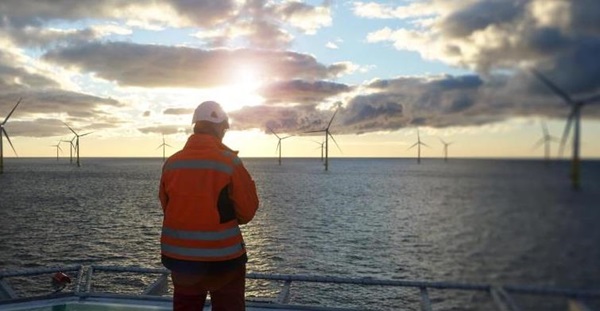Offshore wind isn’t something new. For decades, it has been heralded as a cornerstone of the global shift to renewable energy. But the reality remains: despite immense advances, it still needs to demonstrate progress from ambition to real outcomes.
While offshore wind’s transformative potential is immense, particularly as we look to transition energy sources, it is largely constrained by bottlenecks in regulation, technology and collaboration. What if we could break these constraints? What if offshore wind is more than an energy solution - an economic catalyst and force for climate resilience on a global scale?
Realizing this vision demands to scalable actions that cut across sectors, borders and disciplines. This challenge set the scene for Arcadis' Offshore Wind School, held in Glasgow as part of the Energy Transition Academy, powered by the Lovinklaan Foundation. Over 60 leaders, experts, clients and academic partners from around the world came together to reimagine offshore wind’s role, identifying three critical paths forward: transforming regulatory structures, advancing technology and workforce readiness, and forging dynamic partnerships that drive impact. These themes underscore the global actions needed to expand offshore wind’s reach and elevate it to accelerate a truly sustainable, inclusive energy future.
A New Framework: Offshore Wind’s Role in Global Energy Resilience
While offshore wind is gaining momentum, it also faces varying regional challenges. The Global Wind Energy Council estimates that, with sufficient policy support, offshore wind capacity could grow to around 410 GW by 2033. While optimistic, this growth still falls short of IRENA’s ambitious target of nearly 500 GW by 2030 - a level required to keep global warming below 1.5°C.
The expansion needed calls for a visionary and coordinated approach. This means balancing environmental safeguards, local economic needs and social equity considerations with the speed of deployment.
So, what does that investment and return – beyond the obvious – look like? In the UK, achieving 50 GW of offshore wind by 2030 means a significant workforce expansion to over 100,000 professionals. In the U.S., deployment targets of 30 GW by 2030 create a to address critical challenges like limited workforce experience and regulatory delays. Across these regions, aligning ambitions with action will depend on building capacity and sharing best practices.
Critical Path 1: Breaking Down Regulatory Barriers
Navigating regulatory landscapes is essential to unlocking the full potential of offshore wind. Sandy McTaggart, Director of Offshore Grids at Scottish and Southern Electricity Networks (SSEN), reflected on this challenge, emphasizing the need for bold policy reform.
SSEN is investing significantly in Scotland's renewable infrastructure, including high-voltage direct current (HVDC) systems designed to connect offshore wind energy efficiently to the grid and meet the nation’s ambitious climate targets. Under a five-year framework, Arcadis supports SSEN’s mission to deliver infrastructure that accommodates 10 GW of renewable generation by 2026. This work includes multi-disciplinary support from civil and structural engineering to telecommunications, laying a robust foundation for SSEN’s sustainable delivery model and future-proofing their network.
-
Read more
In Brazil, Arcadis is supporting early-stage offshore wind planning through socio-environmental pre-feasibility studies along the coast, identifying optimal sites and potential environmental impacts for over 10 GW of capacity. This includes mapping socio-environmental constraints and designing preliminary project layouts to streamline the permitting process.
Experience across these two projects bring to light a clear learning - governments must enact clear, standardized permitting processes that not only prioritize renewable projects but also shorten approval times while preserving environmental standards. At Arcadis we understand this and bring deep expertise from regulatory projects worldwide, including support for the Netherlands’ North Sea Wind Power Hub.
Critical Path 2: Advancing Technological and Workforce Innovation
The path to scalability in offshore wind also lies in technological and workforce innovation.
Working at that very intersection of technology and talent development is key to ensure the long-term effectiveness of this transition. Arcadis’ Energy Transition Academy, in partnership with clients and academic partners like Strathclyde University helps upskill both current and next-generation professionals. By identifying and focusing on skills and technology development crucial to the offshore wind sector, from environmental impact assessments to HVDC expertise, we can ensure a workforce that is prepared for the energy challenges of tomorrow.
Critical Path 3: Building Dynamic Networks and Partnerships
Achieving a sustainable offshore wind future requires a systems thinking approach and cross-sector partnerships that integrate public policy, private sector investment and academic insights.
Arcadis’ involvement in Germany’s Rhein-Main-Link project exemplifies our role in fostering large-scale partnerships that drive offshore wind integration. The 500-kilometer transmission route will channel offshore wind energy from the North Sea to the Rhein-Main region, addressing the high energy demands of 5.8 million inhabitants and local industries. This critical project, aligned with Germany’s 2045 climate-neutral target, underscores how bridging the right expertise with the right partnerships can optimize grid connections for offshore, and build momentum toward sustainable growth.
The Path Forward: Shaping a Legacy of Positive Impact
Offshore wind, with its vast potential and complex challenges, stands as both a climate solution and a legacy in the making.
For Arcadis, the path forward is clear: prioritizing regulatory cohesion, embracing technological and workforce advancements, and cultivating collaborative networks that amplify results. As the discussions at the Offshore Wind School illustrated, achieving these goals require not only technical expertise but a visionary commitment to harnessing offshore wind’s potential for a planet positive future.
Leveraging our role as a sustainable transformation partner, we’re committed to accelerating the adoption of offshore wind. We recognize that this journey is about more than powering cities and industries; it’s about creating a legacy that the next generation will inherit – a resilient, climate-positive future that serves communities, fuels economic growth and transforms our planet for the better.










